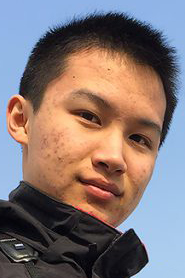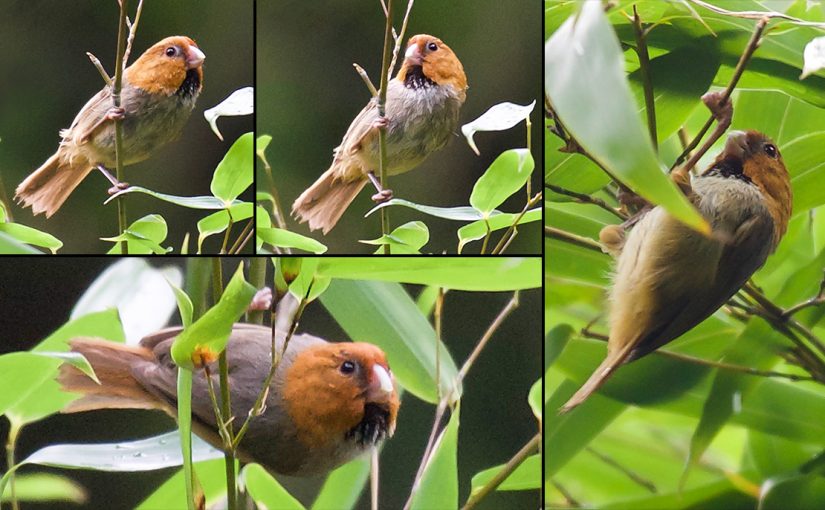Short-tailed Parrotbill (above) is perhaps the most compelling of the south China specialties found at Tianmushan. In this second of our two-part series on the Tianmu Mountains, Shanghai birder Komatsu Yasuhiko tells us of his July 2018 trip to the mountain in Zhejiang. — Craig Brelsford
by Komatsu Yasuhiko
for shanghaibirding.com

Eight members of our school birding club, five experienced birders and three beginners, visited the Tianmu Mountains July 2-6, 2018—a week before the high season, so as to avoid the influx of tourists. Despite the high humidity that early on knocked my camera out of action, our club managed to find many species native to south China that are unattainable in Shanghai.
On the day of our arrival, we followed our routine from July 2017 and hiked between our inn, Haisen Nongzhuang (海森农庄), and another inn around 2 km uphill, Qinquan Shanzhuang (清泉山庄). The hike takes around 40 minutes one way and is famous in our club for its reliable Short-tailed Parrotbill, a species that in China occurs only in a small range in the southeast. The parrotbills are most readily found around dawn and evening.
At the abandoned inn Yulong Shanzhuang (玉龙山庄), located on the shore of the lake, we spotted nests of Asian House Martin forming dozens of rows on the dilapidated three-story building. Hundreds of adults were lined up on the edge of the roof, forming what seemed at first glance like a neat row of pebbles. The sky was filled with a swarm of adults circling around like a tornado.
On the side road that brought us down to the inn was a Huet’s Fulvetta, a nice addition to the day list. Continuing along the main road, we heard and saw a flock of Short-tailed Parrotbill, next to the bamboo forest just several hundred meters away from where we had them last year. Since we had some spare time, we continued uphill for another kilometer or so from the inn originally intended to be our destination, finding a Brown Dipper feeding in the stream along the way.
Since the walk does not require much time, we had many morning and evening walks between the two inns, during which we had more sightings of Short-tailed Parrotbill and visuals on Streak-breasted Scimitar Babbler, Chinese Sparrowhawk, Rufous-faced Warbler, White-crowned Forktail, Meadow Bunting, and Common Kingfisher. We were further motivated to take the morning and evening walks here due to the presence of a staircase leading directly to the stream next to the inn at the destination, where we frequently sat on the rocks and soaked our tired legs in the clear, cool water.
On the second day, we were planning to take the hotel shuttle bus up to Longfengjian (龙凤尖), the entrance of the scenic area, so that we could hike back down the road. Upon finding that we did not have tickets for the scenic area, the bus driver dropped us off 7 km away from the destination, at a guard post beyond which only shuttle buses, authorized vehicles, and pedestrians are permitted access. We decided to bird the road 7 km up to Longfengjian.
It was an exceptionally humid day for an already humid place, and it showered regularly throughout our three-hour walk. During the hike, our ears were filled with the cat-like calls of Black Bulbul, the cricket-like trills of Rufous-faced Warbler, and the whistling song of Brown-flanked Bush Warbler. Every few minutes, trees beside the road were flooded with mixed flocks of Indochinese Yuhina, Black-throated Bushtit, Japanese White-eye, and Yellow-bellied Tit. Flocks of Black Bulbul, Light-vented Bulbul, Chestnut Bulbul, and Vinous-throated Parrotbill were also very common. Plumbeous Water Redstart marked every few meters of the stream, and Asian House Martin frequently flew over our heads.
Our first highlights came about 2 km up the road. On the hillside, we were able to spot Red-billed Leiothrix and Streak-breasted Scimitar Babbler. After walking another hundred meters uphill along the road, we heard a Spotted Elachura from deep inside the vegetation. Using playback, we were able to draw it closer and make a recording, but we were not fortunate enough to obtain a visual on the secretive bird. Around halfway to the destination, a White-crowned Forktail hopped out of the ditch next to the road and came into full view. On the last several hundred meters of the road, we were able to spot 2 Grey-capped Pygmy Woodpecker mixed in a flock of Indochinese Yuhina, Japanese Tit, and Black-throated Bushtit.
On the third day, we declined to bird due to inclement weather. On the last day, the weather cleared enough for us to enter the scenic area. While fending off leeches hiding along the narrow mountain trails and fixing our eyes on the steep staircases, we managed to find a Little Forktail and a Blue Whistling Thrush at a pavilion next to a narrow stream. We also had a flock of Grey-chinned Minivet flying over our heads.
Upon reaching the bus stop, only a few of us had the stamina to continue up to Xianren Ding (仙人顶), the peak, so the club split up. The group climbing up the peak, which included me, had visuals on a Eurasian Jay, Brown-flanked Bush Warbler, and Great Spotted Woodpecker. At the very peak, we were rewarded with a Chestnut-bellied Rock Thrush on the weather station tower—a lifer for many of us. The way down was nearly disastrous, however, as we were pounded by heavy rain. Meanwhile, the group resting at the temple close to the bus stop had a Eurasian Jay and a Great Barbet on a treetop.
West Tianmu is a great choice for us students, since we are on a budget and have little means of transportation available to ourselves. To do this trip, instead of taking the bullet train like last year, we took a bus running regularly between People’s Square in downtown Shanghai and our inn at Tianmu. Taking this bus greatly increased our birding time, as it saved us the trouble of transferring to different vehicles multiple times. We recommend West Tianmu without reservation to anyone wishing to get bonus lifers in addition to the regular coastal and city birds around Shanghai.
FURTHER READING
This post is the second in a two-post series about birding in the Tianmu Mountains.
Tianmushan: A Must See Site for Shanghai Birders (Part 1)
Tianmushan: A Must See Site for Shanghai Birders (Part 2)
More posts on Tianmushan:
Tianmushan in July
Tianmushan in Autumn
Koklass Pheasant Highlight Tianmu Trip
See also our coverage of other areas in southeast China:
Birding Emeifeng, Fujian (Part 1)
Birding Emeifeng, Fujian (Part 2)
Home to Shanghai (Plus a Jaunt to Fujian)
Trip Planner: Fuzhou National Forest Park
Nonggang Babbler: From ‘New to Science’ to ‘Automatic Tick’
Featured image: Short-tailed Parrotbill Neosuthora davidiana, Tianmu Mountains, Zhejiang. (Komatsu Yasuhiko)


Great post Hiko. I hadn’t realized how close Tianmu is to Hangzhou, where I live. I will have to get up there soon. Maybe you can join our group again, as your guidance would be appreciated. A spring trip looks like a good option. Great to see that your school has a bird club. I have probably been a bit lazy about getting my HIS students out to look at the local wildlife.
Excellent write up Hiko. You’ve encouraged me to take a trip to 天目山。 I was wondering – what bus do you take from People’s Square and how long does it take to get there? Keep up the good work.
Thank you Paul! The bus can be booked by calling the inn you are staying in. For us the inn was 海森农庄, but other inns should work as well, since the bus has multiple destinations in the Tianmu area. The ride only takes 4~5 hours from People’s Square and this allowed us to have lunch and afternoon birding at Tianmu on the first day.
Short-tailed Parrotbill is a bird I’d like to see – Thanks for the trip report !
We saw Elliot’s Pheasant at Tianmushan a few weeks ago.
Congrats on Elliot’s, Tom! Look what happens when a great spot like Tianmu gets better coverage by good birders.